Catdoll User Guide
Congratulations on your Catdoll purchase! This guide is designed to provide you with comprehensive information about your product and to ensure you fully enjoy your Catdoll experience. A Catdoll is not a mere toy; it is a valuable item that requires attention and care, just like a real person! As the owner, it is your responsibility to maintain and protect your doll diligently so that you enjoy your purchase for years to come!
Product Overview
Catdolls are made using one of two materials: thermoplastic elastomer (TPE), and soft or hard silicone. These materials have their own characteristics, and must be treated and maintained differently.
TPE (Thermoplastic Elastomer):
- Softness and Flexibility: Known for its realistic, skin-like feel, TPE is soft and flexible.
- Elasticity: Highly elastic, it can stretch and bend significantly without damage.
- Cost: Generally more affordable than silicone.
- Maintenance: TPE is porous, prone to staining, and requires regular cleaning and powdering to maintain its texture.
- Durability: Durable but less resistant to high temperatures and harsh chemicals compared to silicone.
Silicone:
- Realism and Detail: Offers excellent detail and realism, closely mimicking human skin and capturing fine details better than TPE.
- Durability: Highly durable and resistant to tearing, high temperatures, and chemicals, making it long-lasting.
- Maintenance: Non-porous, easier to clean, and less prone to staining, requiring less maintenance than TPE.
- Cost: Generally more expensive than TPE due to its superior properties and longer lifespan.
- Feel: Less flexible and slightly firmer than TPE, which can impact the overall tactile experience.
EVO and Non-EVO Skeleton Construction


The difference between the EVO and non-EVO skeletons is the inability for the non-EVO back to bend sideways or move the shoulders up and down or forwards and backwards.
If you need to perform repairs, contact us for instructions and more detailed photos of the internal skeleton.
Range of Motion
Head and Neck
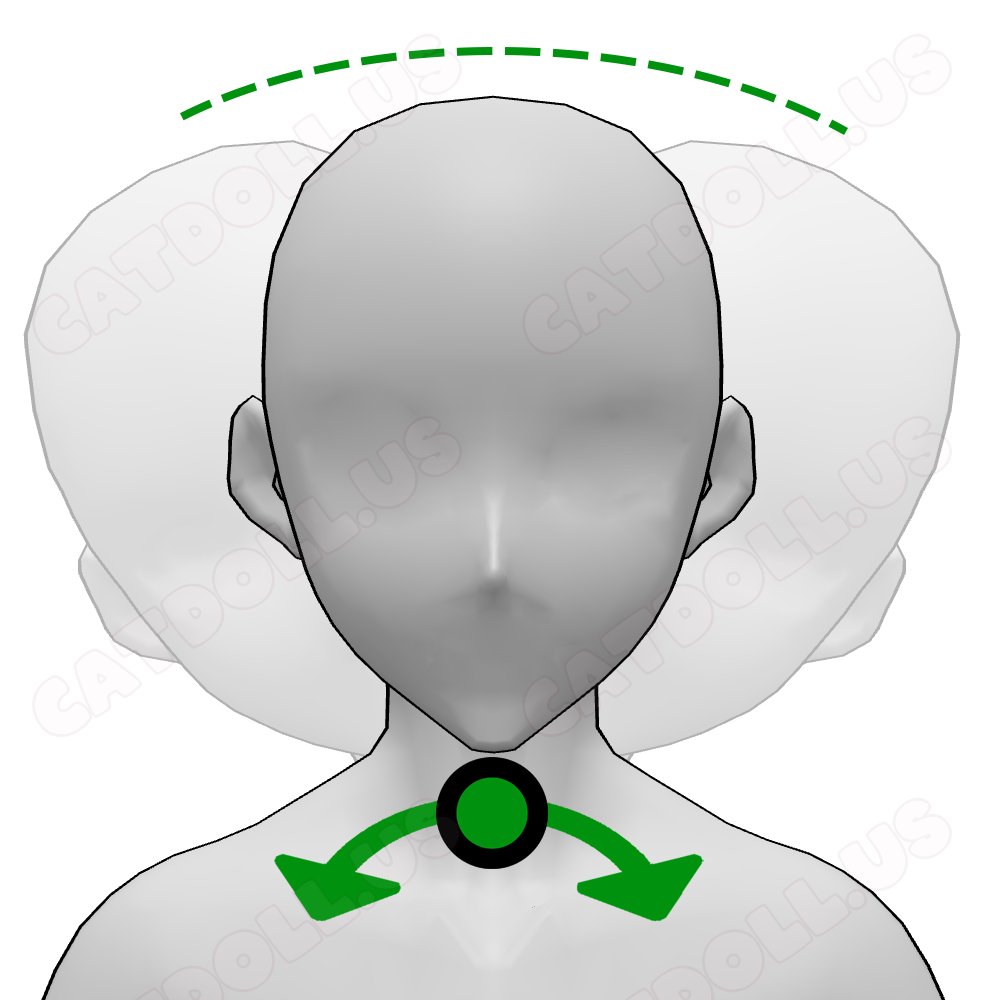
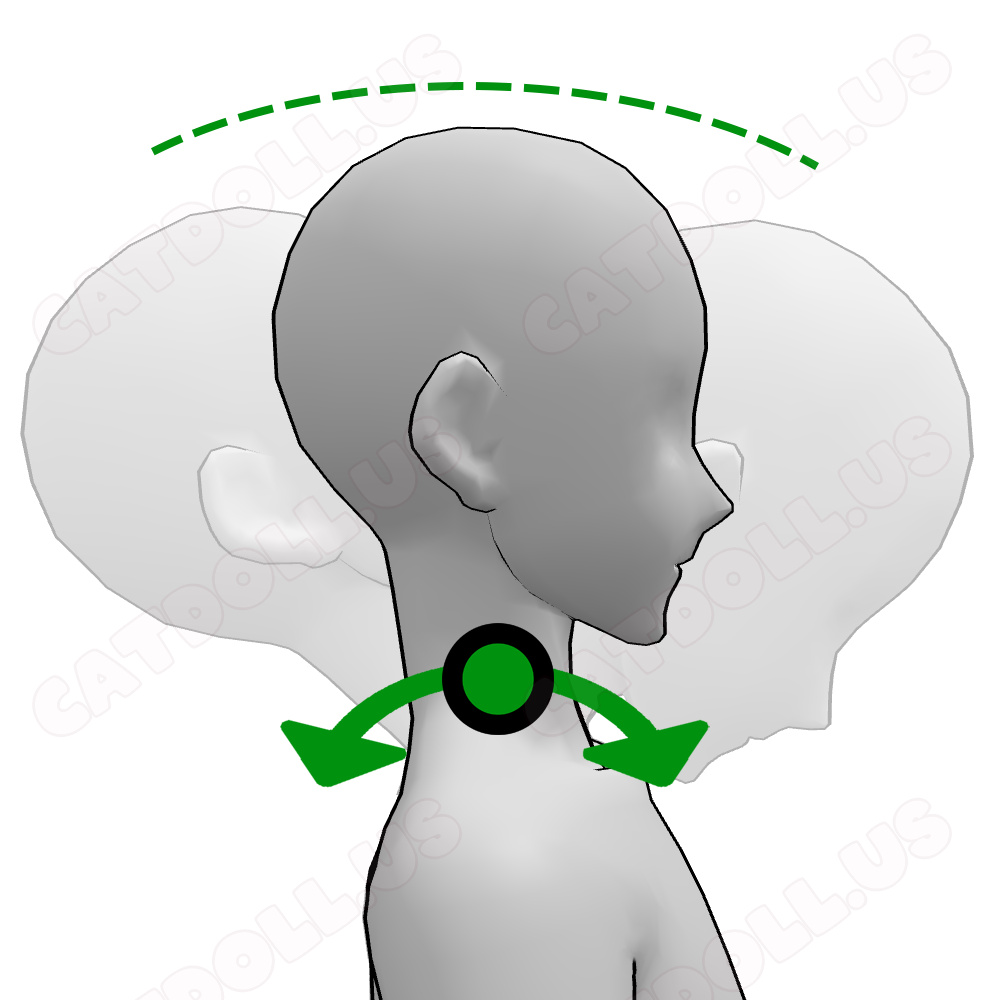
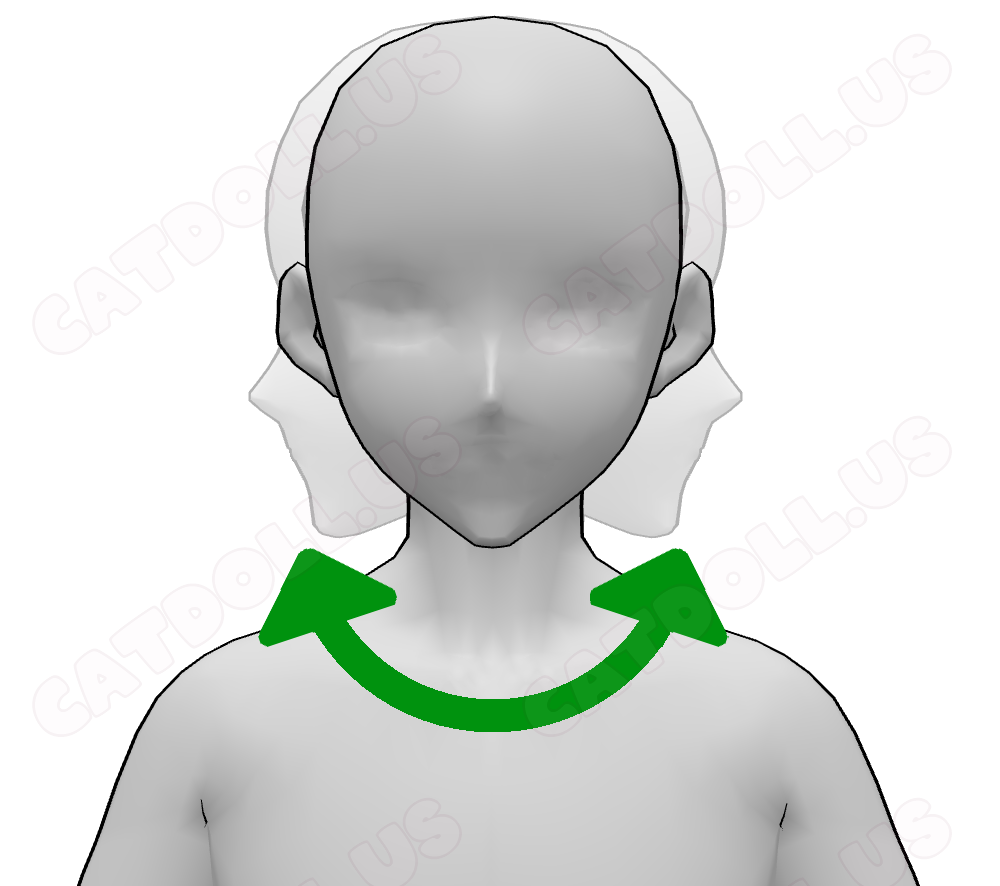
The head can move forward, backward, and can rotate 360°.
The head is connected to the body by using the included M16 quick connect bolt. The connector should be screwed into the neck of the body, and the head will click into place. The 2 black hex screws on the side can be adjusted using the included hex key to make it easier or harder to remove the head. If you find that the head comes off too easily, you should tighten the adjustment screws.
The head should not be bent at an angle exceeding 45° for extended periods of time.
Upper Arms
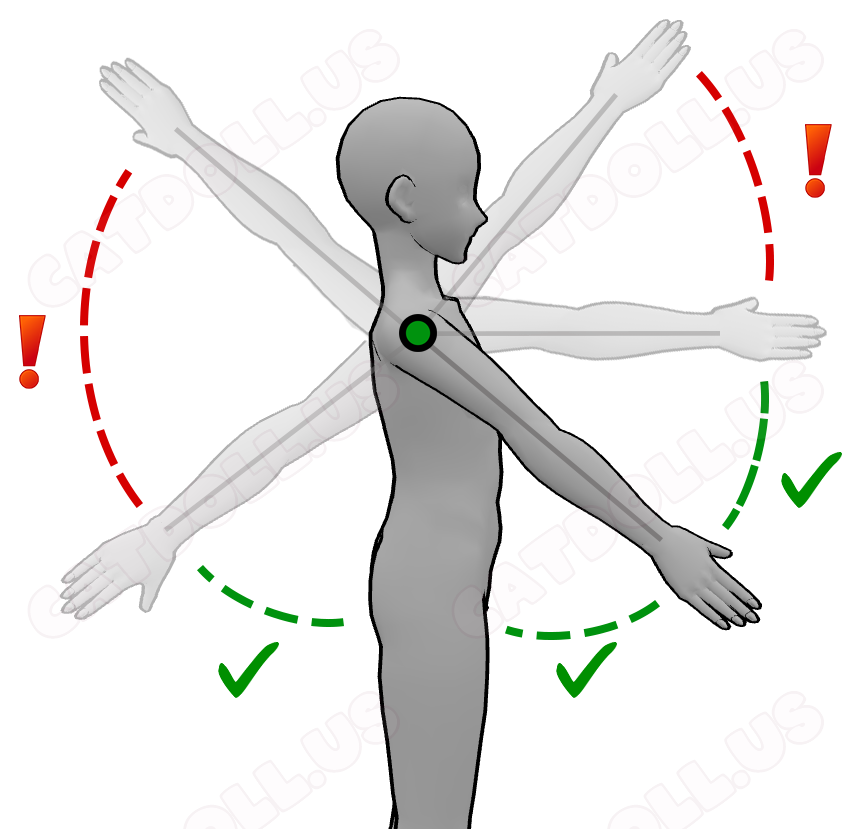
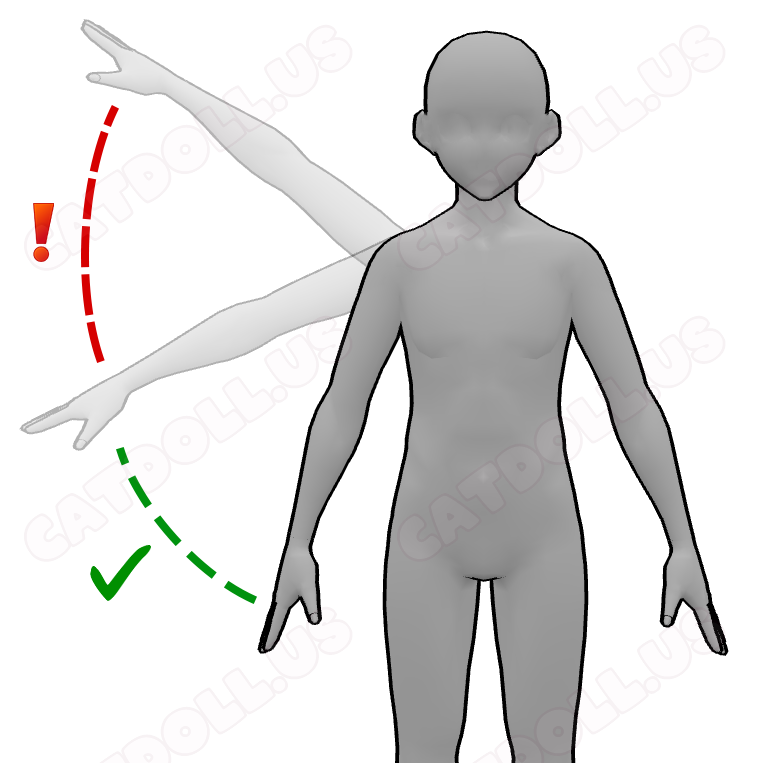
The arms can be raised to the side and forwards and backwards up to shoulder level. While they can be lifted beyond that, it is not recommended as it puts a lot of tension on the armpit.
Shoulders (EVO Skeleton Only)
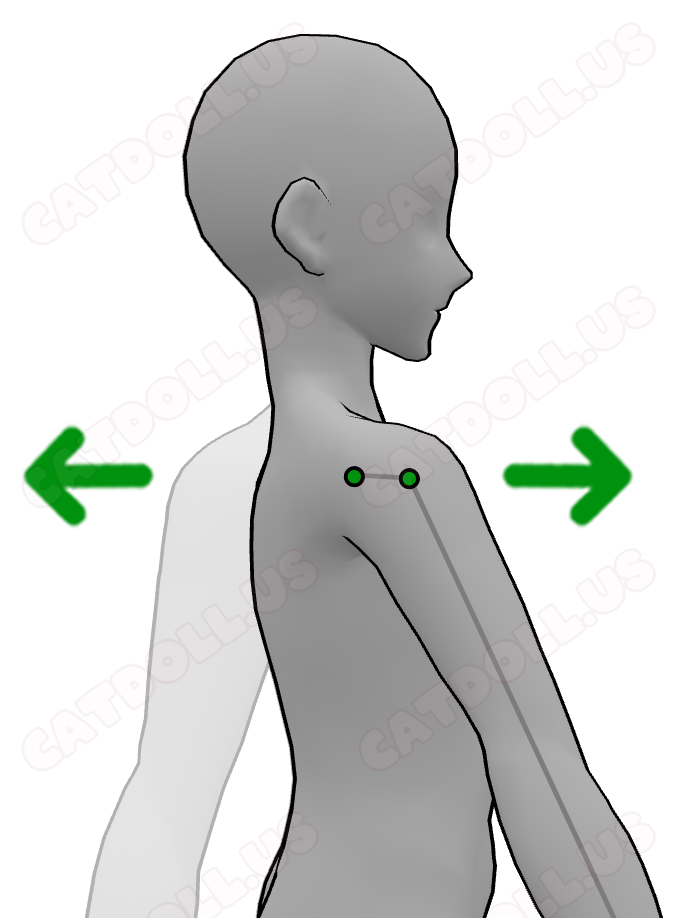

EVO skeleton shoulders have the ability to raise and lower as well as forwards and slightly backwards.
Lower Arms
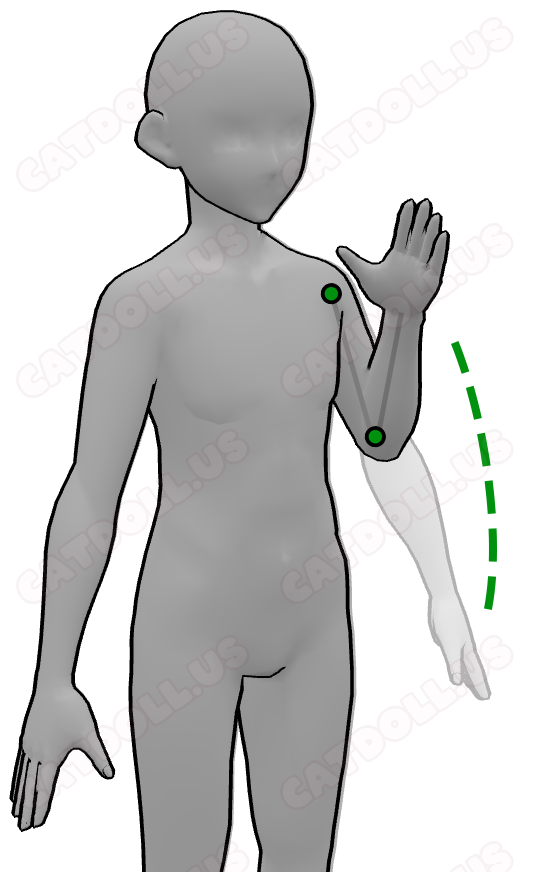

The elbows have a full range of motion, just like human elbows. The elbows can bend up to 180° and rotate side to side as well. It is not recommended to leave the elbows bent at a sharp angle for long.
Wrists
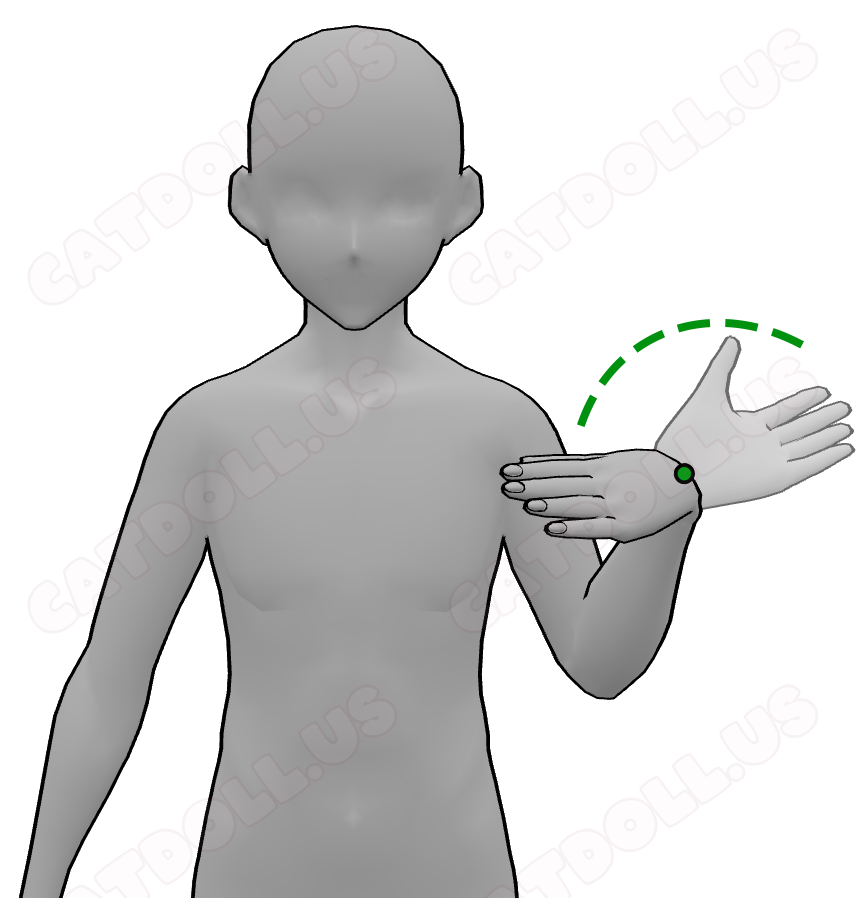
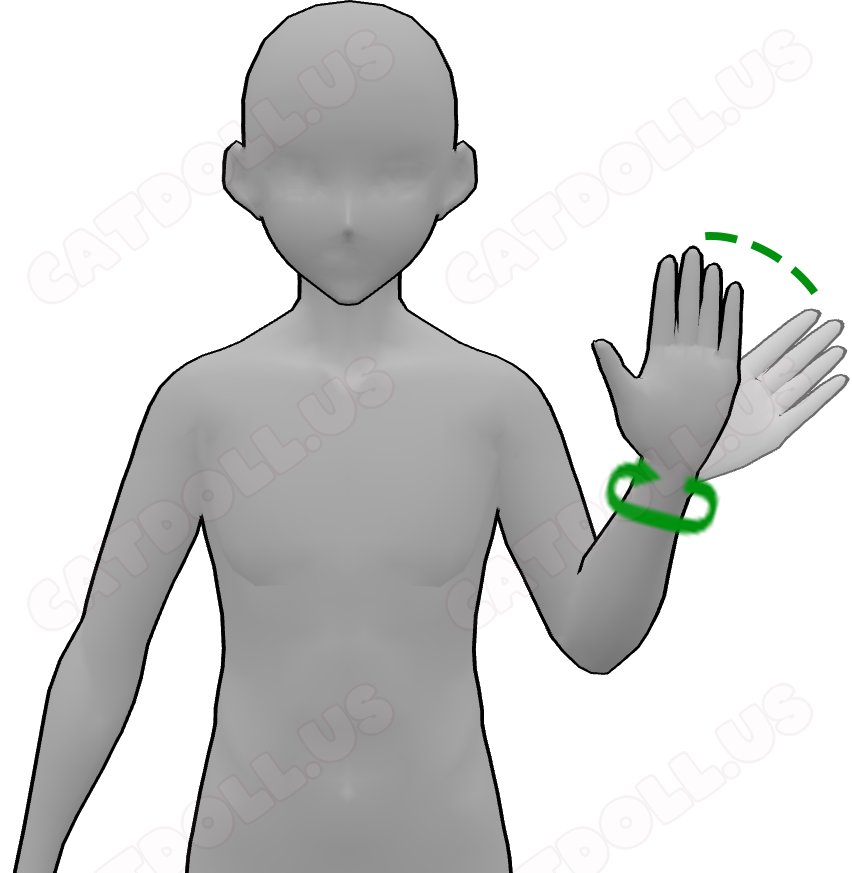
The wrist joints allow the hands to be bent forwards or backwards, as well as to be rotated from side to side.
Be careful not to twist the wrists and forearms too much. It will look odd and puts extra tension on the material.
Hands
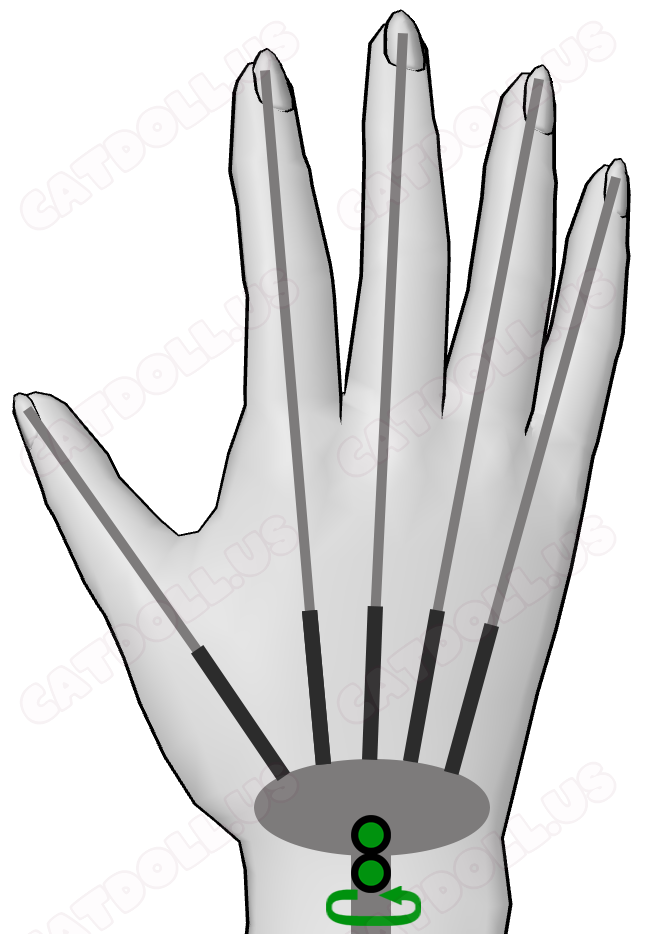
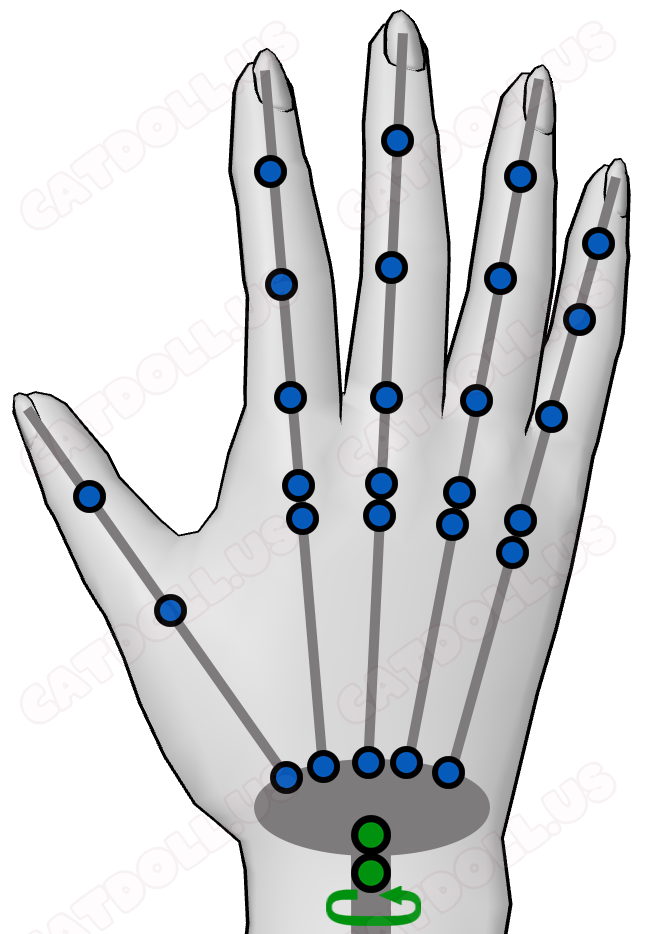
Catdoll offers two hand configurations: wired fingers and articulated fingers.
Articulated fingers have several joints which mimic the skeleton of a human hand. Be careful because they are very delicate, and the joints cannot bend backwards.
Wire fingers are made of heavy gauge wires that extend from the base of the hand to the end of the finger. It is not recommended to bend the finger wires often, as it increases the possibility of breakage.
Regardless of hand design, it is important to be extremely careful with hands and fingers, as they are delicate and can break with careless handling. Always keep them in mind when moving or posing your doll.
Waist
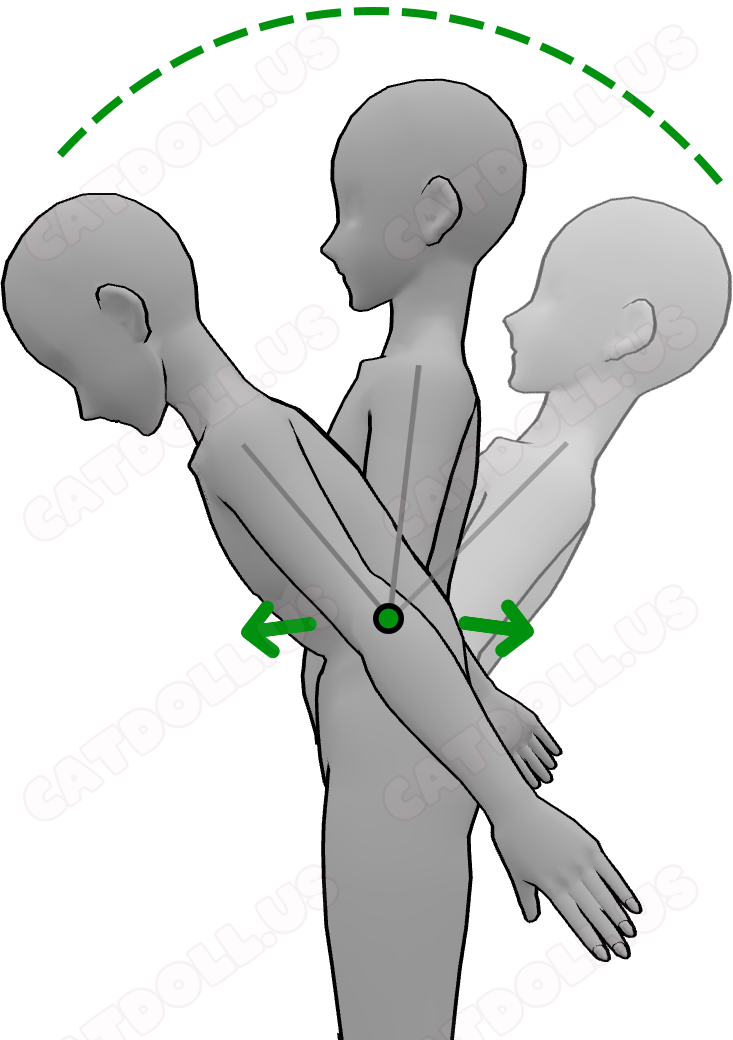
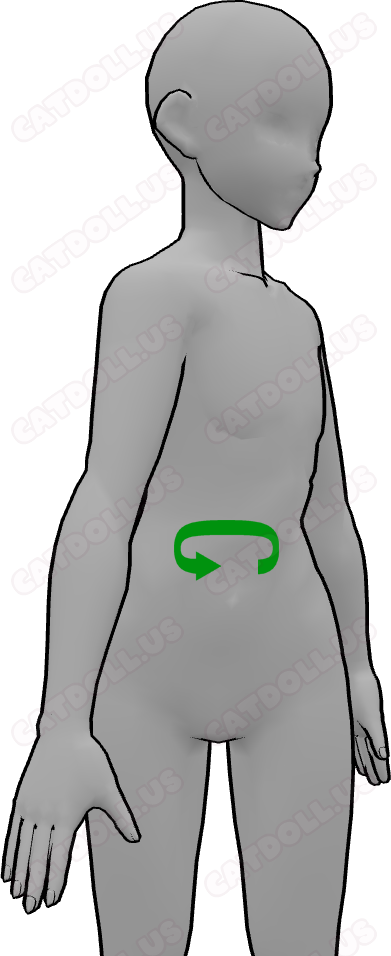

The waist can bend forwards and backwards, twist in both directions, and be bent either left or right with the EVO skeleton.
Upper Legs
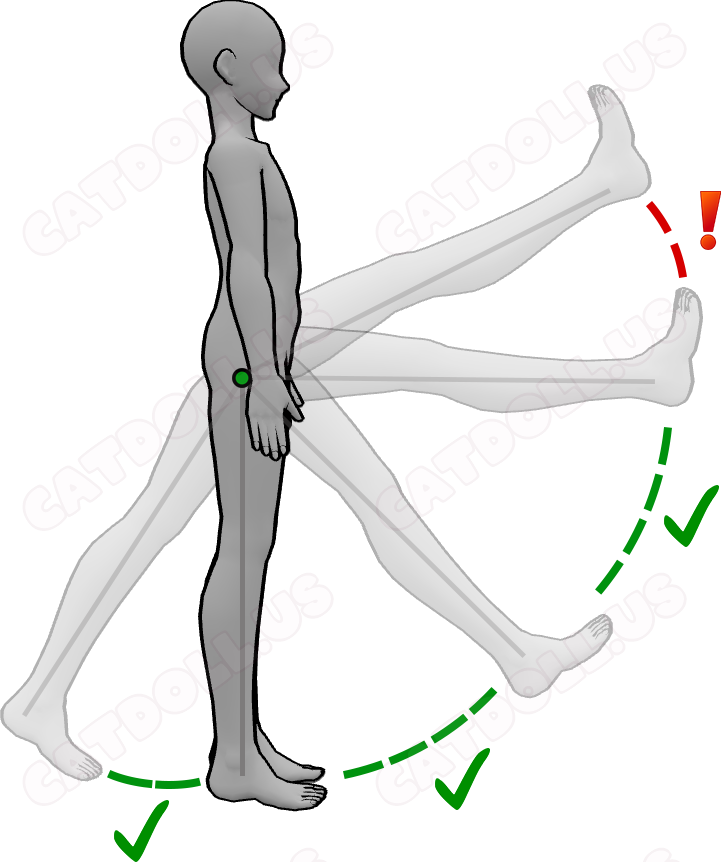
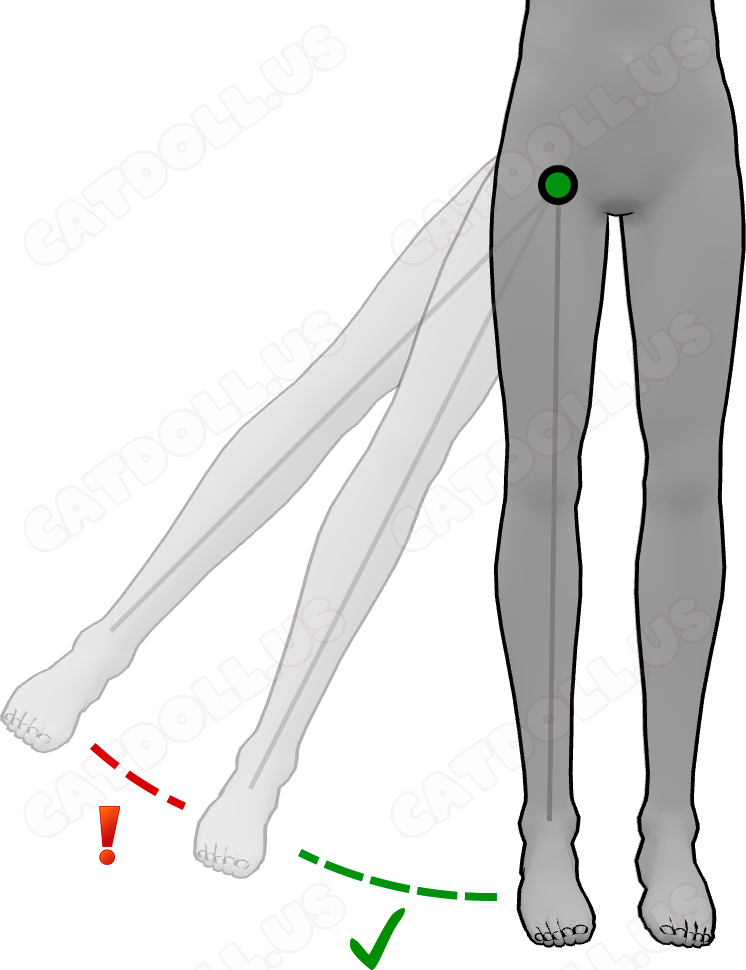
Legs can bend fully forward and slightly backwards, like a human leg. It is not recommended to raise the leg beyond 90° forward for long, as it increases the tension in the material and can create permanent creases in the groin.
Side-to-side bending of the legs should not exceed 50° to prevent tearing from occurring in the groin and orifices.
Lower Legs

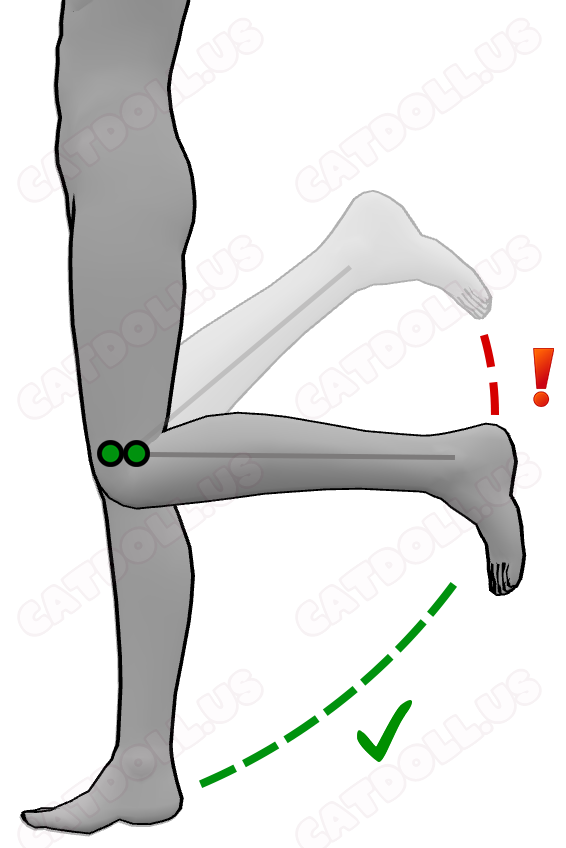
The lower leg can be bent backwards up to 150°, but not at all in the other direction, like a human knee. It is not recommended to bend the knees beyond 90° for long, as it greatly increases the tension and chance of tears.
The lower leg can also bend from side to side. Though it is possible to fully rotate the lower leg, it is not recommended to rotate the lower leg more than 90° to either side.
Never place your doll on a hard surface with the knees bent, as the weight of the doll may cause the knee joint to cut through the stretched material.
Feet

The feet can be bent 90° downward, slightly upward, and rotated from side-to-side. Do not attempt to twist the foot beyond 50°.
Do not lean your doll too far forward to prevent foot damage.
The big toe contains a wire. Please be mindful of it.
Standing Feet

Dolls with standing feet will either have hard silicone soles, or have three foot screws – one in the heel, and two more towards the end of the foot near the toes. These options allow the doll to be stood upright indefinitely, but extreme care must be taken to ensure the doll does not fall over.
While high heels may look wonderful, it is not recommended to attempt to stand dolls in them, as they put too much stress on the front of the foot and increase the risk of damage and falls.
Poses to Avoid


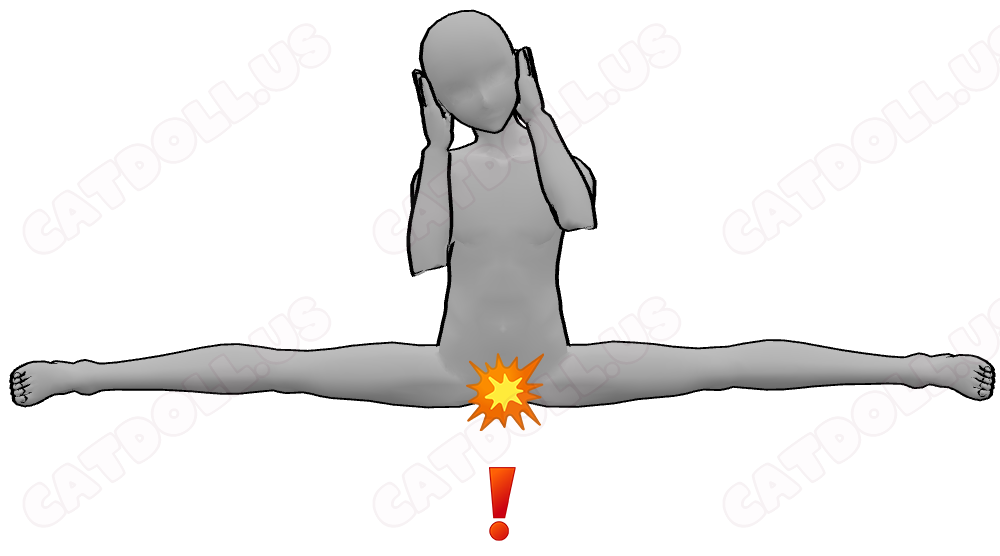

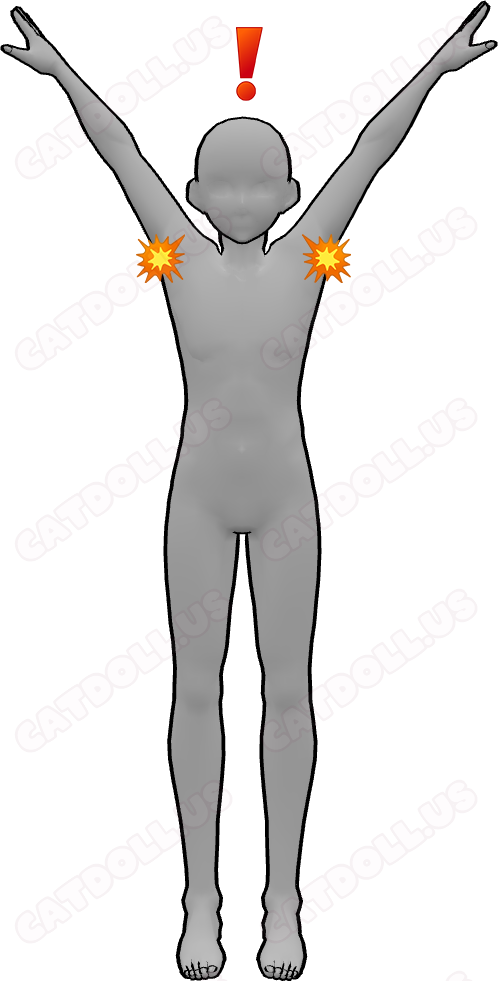
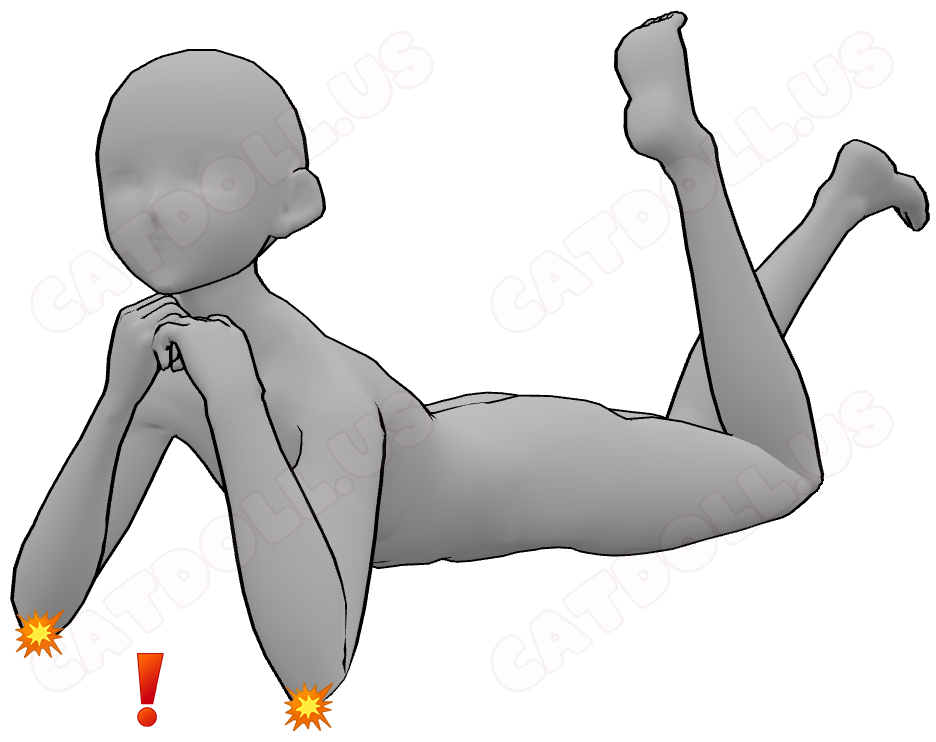
Cleaning and Maintenance Instructions
This section is a guide for the cleaning, maintenance, use, transportation, and storing of your doll. Please take time to familiarize yourself with the contents and refer to this section if you have any questions about any of those topics. This is not meant to be a complete guide, so contact your vendor if you have questions that are not answered here.
Cleaning
Always wash your doll’s orifices after each use with mild antibacterial soap and water that does not exceed 40°C (104°F).
It is recommended to flush the holes out with cold water before cleaning. There are several techniques to clean orifices, but whichever method you choose, ensure that the orifices are completely dry afterward to prevent harmful bacteria and molds from forming. Such bacteria and molds can cause infections!
Use mild antibacterial soap and water to clean any area that comes in contact with bodily fluids. Remember that TPE is porous.
It is recommended to remove the head and clean it separately, following the same advice as with the orifices on the body.
Do not submerge the feet, body or head in water, as it can enter the metal skeleton from openings in the feet, neck, and any cuts that expose the skeleton. Water can cause the skeleton and joints to rust, making them both brittle and the joints difficult to bend.
To clean the surface of a TPE doll of dirt, dust, debris and some stains, rub mineral oil on the surface with your hands or a soft microfiber cloth until the dirt is removed. Remember that mineral oil removes makeup, so avoid rubbing eyebrows and around the mouth.
Silicone dolls can be cleaned with mild antibacterial soap and a soft cloth. Always lightly pat dry; do not wipe to dry.
When cleaning the surface of the doll, do not use rough materials or apply too much pressure when wiping. Excessive pressure and rough surfaces can cause friction damage to the surface.
Never use a heat gun or blow dryer to dry a doll’s surface or insides, as heat can cause surface damage and can melt TPE.
Maintenance:
TPE (and sometimes soft silicone) will feel tacky unless it is powdered. There are a few powders that can be used. The most common powder to use is corn starch, but other powders such as talcum powder, baby powder, arrowroot powder, and rice flour also work.
Powder the doll after each use, and every few weeks to maintain the velvety feeling. This has the added benefit of keeping dust from sticking to the surface and makes it easier to put on clothing.
Beware certain clothing materials, and clothing which is not color transfer resistant. Colored fabrics that bleed can create stains on the surface of the doll that can be permanent or very difficult to remove. Wash new clothing at least once before putting on your doll.
Materials to be careful with are denim, leather, suede, velvet, dark-colored fabrics and low-quality fabrics.
TPE can seep oil into clothing and certain surfaces, drying out the doll and possibly staining clothing and surfaces. Avoid leaving TPE dolls dressed in clothing that absorbs oil for extended periods.
Contact us for stain removal guidance. Note that some stain removers will also remove super makeup.
Avoid direct sunlight for extended periods of time, as the ultraviolet radiation (UV) in sunlight causes TPE to chemically break down and can make it lose elasticity and tensile strength. Direct sunlight can also cause color fading.
Dolls should be kept in a cool, dry location. As TPE has a low melting point (as low as 80°C or 176°F), they are susceptible to heat degradation if exposed to high temperatures. Avoid keeping dolls in areas or rooms where the temperature exceeds 32°C (86°F).
Do not leave your doll seated or with limbs bent for extended periods of time. Constant tension and folds in the material increases the likelihood of tears and permanent creases.
Contact us before attempting any repair to the surface or skeleton. The provided diagrams in this guide are meant to provide basic instructions on the use of the internal skeleton, not to be used as a guide for attempting repairs.
Nails and eyelashes that come off can be reapplied using a thin layer of superglue. Be careful and avoid getting glue on the eyes.
Makeup Maintenance
Makeup on silicone dolls is permanent if the doll is well-maintained, but it will fade over time on TPE dolls.
Test makeup on an inconspicuous area or on a piece of scrap material before applying makeup to the doll.
Use non-toxic, preferably water-based makeup, especially when applying to areas such as lips or any orifice. Apply makeup slowly and sparingly, using soft brushes and sponges.
Avoid rubbing mineral oil on the lips or eyebrows when cleaning, as mineral oil removes makeup from the surface of TPE. It is not recommended to use mineral oil on silicone dolls.
Avoid excessive friction, especially with rough surfaces. This can cause surface damage and remove makeup on both TPE and silicone.
Wig and Implanted Hair Maintenance
Gently brush the hair regularly using the provided comb or detangling brush to remove tangles and knots. Always start brushing at the bottom and work upwards to the roots to avoid damaging the hair fibers and creating additional knots.
Wash the hair periodically in cold water with shampoo specifically designed for the type of hair that your doll has. Follow the instructions on the bottle carefully.
Dry the hair by patting with a dry towel or place on a wig stand and allow to dry naturally. Never use heat to dry synthetic wigs.
Avoid storing in such a way where the wig or implanted hair can become tangled easily. Moving the doll, sexual use, photography, fans, and sleeping with the doll can cause the hairs to become tangled more easily.
Condition the wig with a conditioner specifically designed for the kind of wig or implanted hair your doll has.
It is normal for some implanted hair to come out when brushing, especially when new. Always brush gently and do not try and forcefully detangle knots. Consult your vendor if the implanted hair is coming out too much.
Usage Tips
Only use water-based products, regardless of the material of the doll. Never use silicone or petroleum based products, as these chemicals degrade both TPE and silicone.
Always use a generous amount of lubrication when inspecting the orifices in order to prolong the life of your doll. Failure to do so will result in tearing. Never attempt to inspect any orifice without lubrication.
Always adequately clean and dry every orifice used immediately after. Bacteria and mold thrive in damp, dark places, and can cause health problems.
Do not pose your doll in ways that cause excessive pressure on any joints, particularly the wrists, elbows, or knees. For positions like crawling on elbows and knees, ensure the weight of your doll is supported by something soft, like a large pillow.
Playing with the doll creates wear for both the skin and skeleton. The more you play with your doll, the likelihood of skin damage and joint loosening increases.
Moving Tips
Dolls are heavy and do not move on their own. Always be careful and patient when attempting to move a doll.
Plan the route which you will take when moving your doll. Make sure that there are no obstacles that may touch the doll, or that may cause you to trip, stumble, or fall.


Some methods for safely moving a doll include the hug carry, the bridal carry, and the rolling method.
To move a doll using the hug carry, straighten and stand your doll facing you, raise the arms slightly, slide your arms under your doll’s arms and pull it tight to your chest. Gently lift your doll several inches off the floor and carefully move to the desired location.
Do not pick up your doll from the armpits, as the pressure can cause tearing or friction damage.
To move a doll using the bridal carry, lay your doll flat, then bend the limbs so your doll is in a seated position. From either the left or right side, kneel or bend down and pick up your doll from under the knees and the middle of the back. Lift with your knees and not your back. Keep your doll tight to your chest, and carefully set your doll down in the desired location.
To move your doll using the rolling method, position your doll into a seated position and carefully place your doll on a chair with wheels. If equipped with standing feet, your doll can also be moved in the upright position using a hand truck or dolly.
Be particularly mindful of feet and hands while moving your doll around, as they can move and hit objects while in transit.
When carrying your doll using the hug or bridal carry, pass through doorways and arches sideways to avoid brushing the head or feet against the door frame and any protruding locking mechanisms.
Storage Tips


When not in use, it is best to store your doll with the skeleton adjusted to the way it was shipped.
Be mindful of pressure points and storing your doll on top of things that may cause creases or indentations. Some creases and indentations may become permanent if left for too long.
Your doll can also be stored using the optional hanging ring accessory. Ensure the hook and whatever it is attached to is capable of supporting the doll’s full weight.
Store your doll in a dust-free environment and cover with a light-colored and color-transfer resistant blanket or sheet.
Ensure your doll is stored in a cool, dry location that does not receive direct sunlight.
It is okay to store your doll in a seated position for short periods, but not longer than 2 hours to avoid stressing the material around the knees.
Periodically check your doll for signs of damage or degradation if stored for long periods of time.
Do not store your doll while wearing tight clothing, or permanent creases may develop.
Protect your doll’s head and hands during storage.
Heads should be stored detached from the body, and heads with implanted hair will ideally be stored on a head stand that is long enough for the hair.
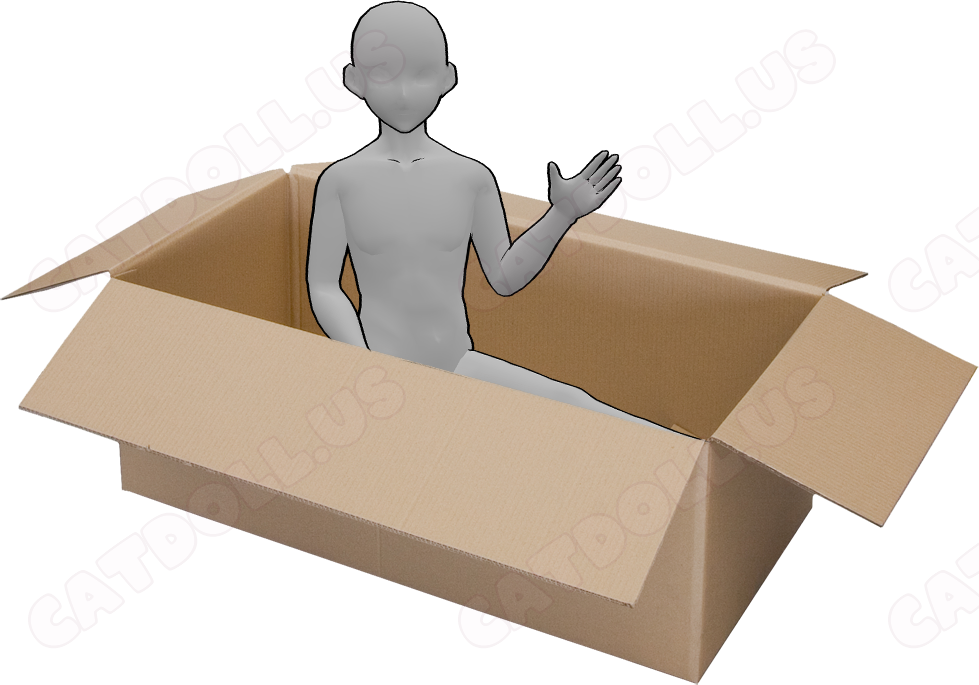
General Tips
Avoid sharp objects, as the doll’s surface is susceptible to tears and cuts. Bent limbs such as knees and elbows need extra caution.
Avoid leaving your doll unattended near pets that have sharp claws and teeth, such as cats and dogs.
Avoid bending or stretching the material beyond the recommended angles to avoid tearing and creases.
Be careful resting your doll on hard surfaces.
Be careful handling your doll if you have long nails, or rough hands, as they can damage the soft surface.
If your doll does not have standing feet, do not attempt to stand the doll upright. Smaller dolls under 30 kg (66 lbs) can stand for short periods of time, provided they are standing on a softer surface such as a carpet or rug.
Never attempt to free-stand your doll. Always make sure your doll is supported against a wall or heavy stationary object.
When standing a doll, make sure it is adequately balanced before stepping away. Falls are extremely hazardous to your doll and may damage objects in the immediate area.
Be mindful of who you allow to know about your doll. Not all people are comfortable around them. Avoid leaving your doll in a location where the public will see, especially if not fully clothed.
When disposing of your doll, consult Catdoll or a trusted vendor for specific instructions. Do not dispose of your doll in a way that may cause the public to mistake your doll for a corpse. Such carelessness gives the public a negative perception of dolls and could result in legal trouble for the owner in some locations.
Because of the way dolls are crafted, it is normal for there to be a seam around the edge of the doll, and should not be considered a manufacturer defect.
Chemicals such as alcohol, bleach, solvents, petroleum jelly, silicone lubricants, and harsh detergents or soaps with a high pH level can harm the surface or paint of TPE and silicone.
Ensure your hands are clean before attempting to handle your doll.
It is not recommended to smoke near your doll, as the smoke can cause discoloration, sticky residue on the skin, and odors to permeate clothing and even TPE.
The doll’s eyes can rotate in all directions. Apply gentle pressure and move the eye slowly in the desired location. Do not attempt to remove eyes from silicone heads or damage may occur.
Heads with adjustable jaws can be tightened and loosened as needed with a hex key located on the side of the jaw. Contact us before attempting to tighten any screws for precise locations and video tutorials.
A reminder: if you have any questions that are not answered in this guide, do not hesitate to contact us for further assistance. Catdoll does not just make dolls; we love dolls and want you to get the most out of your purchase!

